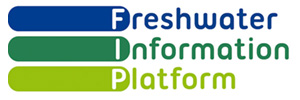Here we aim to bundle a variety of tools, including those that were used and/or developed in the framework of the BioFresh project. We feature:
- spatial/modelling tools
- ecological assessment tools
- literature analysis tools
- R-packages and tools
- GIS tools
The icons for each tool link to the manual, the website, open the tool, show a video tutorial or other relevant information. Just hover your mouse over the icons to learn more.
Freshwater Key Biodiversity Areas
Search for Freshwater Key Biodiversity Areas (KBA) based on parameters such as country, basin type and KBA type.
Search the database at birdlife.org
Freshwater AquaMaps for Europe
Freshwater AquaMaps is an approach to generating model-based, large-scale predictions of freshwater species and is based on a methodology, which was originally developed for marine mammals. Models for the freshwater AquaMaps are constructed from estimates of the environmental tolerance of a given species with respect to elevation, temperature, soil pH, soil moisture, soil carbon, precipitation and the Compound Topographic Index (a wetness index) and occurrence data available through FishBase and GBIF. Maps show the colour-coded relative likelihood of a species to occur in a global grid of half-degree latitude/longitude cell dimensions, which corresponds to about 50 km near the equator.
Predictions are generated by matching habitat usage of species, termed environmental envelopes, against local environmental conditions to determine the relative suitability of specific geographic areas for a given species. Knowledge of species' distributions within FishBase, FAO areas or bounding boxes is also used to exclude potentially suitable habitats in which the species is not known to occur.
Environmental parameter layers and drainage basins based on the Pfaffstetter system have been established for European freshwater fishes, amphibians, and mammals. Parameters were tested by calculating their relative contribution to the predicted distribution patterns for different organisms. Predicted ranges have been tested against IUCN shapefile boundaries based on known distributions. AquaMaps is relatively insensitive to gaps in occurrence data and uses presence only for calculation of ranges.
The European AquaMaps are currently available for a dozen of freshwater species and will be produced for a wider range of species in the near future. These maps can be consulted at European AquaMaps at aquamaps.org
Within the Freshwater Biodiversity Data Portal you can either use the dedicated AquaMaps viewer or visualise the AquaMaps during occurrence searches (if available).
More background information on AquaMaps in general is available at aquamaps.org
Near-global freshwater-specific environmental variables
The dataset consists of near-global, spatially continuous, and freshwater-specific environmental variables in a standardized 1km grid.
The authors delineated the sub-catchment for each grid cell along the HydroSHEDS river network and summarized the upstream environment (climate, topography, land cover, surface geology and soil) to each grid cell using various metrics (average, minimum, maximum, range, sum, inverse distance-weighted average and sum).
All variables were subsequently averaged across single lakes and reservoirs of the Global lakes and Wetlands Database that are connected to the river network. Monthly climate variables were summarized into 19 long-term climatic variables following the “bioclim” framework.
To facilitate the generation of freshwater variables for custom study areas and spatial grains, the “r.stream.watersheds” and “r.stream.variables” add-ons for the GRASS GIS software are provided by the authors.
River Network Toolkit (RivTool)
Freshwater ecosystems are one of the most diverse environments of the world and also one of the most endangered. These systems are affected at multiple scales by the surrounding landscape, including all existing human activities in that area. Integrating environmental landscape data and hierarchic river networks with subsequent summarisation and synthesis of information for large and comprehensive areas at different scales (e.g.: basin, sub-basin, upstream drainage area) is a requirement for an effective research, conservation, and management of river basins. By requiring multiple scale analysis combined with the dendritic nature of river networks and the exponential growth of raw layers of digital information for landscape, these analysis lead to demanding hardware requirements and hardly manageable processing times. Common geographic information systems (GIS) are limited to perform summarisations or automatised calculations along the directed, hierarchical pathways of a freshwater network.
The River Network Toolkit (RivTool) is a software that supports combining and analysing areal information from river basins and hierarchical linear data of river networks. It allows the acquisition of (1) information that characterises freshwater networks based on its topographic nature; (2) data obtained via mathematical calculations that account for the hierarchical and network nature of these systems; and (3) different types of information resulting from up and downstream summarisations. This user-friendly software considers two units of analysis (segment and sub-basin), it uses tabular processes only and is time effective even with large datasets. It contains network, data and label libraries of both ECRINS and CCM2 databases. RivTool facilitates and reduces time required for extracting information for freshwater ecosystems. Thus, it may contribute to increase scientific efficiency, productivity and accurateness when improving or creating novel knowledge on large-scale patterns and processes in river networks.
Maxent
Maxent software for species habitat modeling. Software based on the maximum-entropy approach for species habitat modeling.
Spatial Analysis in Macroecology (SAM)
SAM (Spatial Analysis in Macroecology) is a Windows program designed as a package of tools for spatial statistical analysis, mainly for applications in Surface Pattern Spatial Analysis.
Geospatial Modelling Environment
GME is an analysis and modeling environment for geospatial analysis that is designed to facilitate rigorous analysis of geospatial data. Windows program requiring the statistical software R and ESRI ArcGIS to drive geospatial analyses.
ModestR
ModestR: a software tool for managing and analyzing species distribution map databases
Distance sampling
The Distance project provides software for the design and analysis of distance sampling surveys of wildlife populations. This software takes two forms: a Windows-based program and a suite of packages for the statistical programming language R.
WISER methods database
The WISER methods database details national assessment methods used to classify the ecological status of rivers, lakes, coastal and transitional waters from different EU member states.
More information at wiser.eu
ASTERICS
ASTERICS (version 3.1.1) calculates the ecological status of rivers based on benthic invertebrate taxa lists. The assessment fulfills the demands of the WFD. The German Assessment System PERLODES is part of the software.
An online version is under development and will available end of 2018.
More information at fliessgewaesserbewertung.de
ECOPROF
ECOPROF is the Austrian assessment software to calculate the ecological status of rivers and streams based on macro-invertebrates and phytobenthos. The assessment is in accordance with the WFD. ECOPROF also hosts the Austrian macro-invertebrate inventory as well as ecological preferences of species.
More information at ecoprof.at
EFI+ (Improvement and Spatial extension of the European Fish Index)
The EFI+-tool (Improvement and Spatial extension of the European Fish Index) allows assessing the ecological status of rivers in accordance with the EU Water Framework Directive. The tool is based on the European Fish Index (EFI) developed within the FAME and EFI+ project as a standardized fish-based assessment method applicable across a wide range of European rivers. The EFI employs a number of environmental descriptors (see documentation on the data input matrix) to predict biological reference conditions and quantifies the deviation from reference conditions on a statistical basis.
Taxa Entry Tool
Tool to produce a standardized taxalist for macro-invertebrates macrophytes, fish, phytoplankton or diatoms.
More information at freshwaterecology.info
FORECASTER
Facilitating the application of Output from REsearch and CAse STudies on Ecological Responses to hydro-morphological degradation and rehabilitation.
More about FORCASTER could be found at the REFORM wiki
Tools section a REFORM wiki
STREAMES-EDSS
STream REAch Management: an Expert System. STREAMES-EDSS 1.0 is an Environmental Decision Support System, a computer application that supports the decision-making processes in stream reach management by encompassing heuristic (expert) and empirical information.
More information at streames.net
Eco Evidence
Eco Evidence is a unique tool for performing systematic literature review. It allows users to document and extract causes and effects and their response direction in a standardized manner. As such, the tool helps users to perform a systematic review of the scientific literature focussing on a specific cause-and-effect hypothesis. Eco Evidence consist of an online database and a desktop application for data analysis.
More information about the desktop analyser software (Windows) at eWater Toolkit
CADDIS
CADDIS, or the Causal Analysis/Diagnosis Decision Information System, is an online application designed to help users conduct causal assessments, primarily in stream ecosystems. It provides a logical, step-by-step framework for Stressor Identification based on the U.S. EPA’s Stressor Identification Guidance Document, as well as additional information and tools that can be used in these assessments.
R software
R is a powerful, free cross-platform environment for statistical computing and graphics. This software is required to use the packages mentioned below.
Bioclim - Bioclimatic Variables
bioclim recreates the standard 19 bioclimatic variables (BIOCLIM) created using ANUCLIM or used by Worldclim.
Download at cran or install with install.package("bioclim",repos="http://r-forge.r-project.org")
Biomod
BIOMOD is R-package for ensemble forecasting of species distributions, enabling the treatment of a range of methodological uncertainties in models and the examination of species-environment relationships.
Download at cran or install with install.packages ("BIOMOD",repos="http://r-forge.r-project.org")
dismo: Species distribution modeling
Functions for species distribution modelling, predicting entire geographic distributions from occurrences at a number of sites.
Download at cran or install with install.packages("spatstat",repos="http://cran.r-project.org")
gam: Generalized Additive Models
Functions for fitting and working with generalized additive models, as described in chapter 7 of "Statistical Models in S" (Chambers and Hastie (eds), 1991), and "Generalized Additive Models" (Hastie and Tibshirani, 1990).
Download at cran or install with install.packages("gam",repos="http://cran.r-project.org")
gbm
Generalized Boosted Regression Models. gbm package, found in Elith, J, J. R. Leathwick and T. Hastie. 2008. A working guide to boosted regression trees. Journal of Animal Ecology. 77: 802-813.
Download at cran or install with install.packages("gbm",repos="http://cran.r-project.org")
MASS: Support Functions and Datasets for Venables and Ripley's MASS
Functions and datasets to support Venables and Ripley, 'Modern Applied Statistics with S' (4th edition, 2002).
Download at cran or install with install.packages("MASS",repos="http://cran.r-project.org")
randomForest: Breiman and Cutler's random forests for classification and regression
Classification and regression based on a forest of trees using random inputs.
Download at cran or install with install.packages("randomForest",repos="http://cran.r-project.org")
rpart: Recursive Partitioning and Regression Trees
Recursive partitioning for classification, regression and survival trees. An implementation of most of the functionality of the 1984 book by Breiman, Friedman, Olshen and Stone.
Download at cran or install with install.packages("rpart",repos="http://cran.r-project.org")
spdep
Spatial dependence: weighting schemes, statistics and models.
Download or install with install.packages("spdep",repos="http://cran.r-project.org")
spatstat
An R library for spatial statistics.
Download at cran or install with install.packages("spatstat",repos="http://cran.r-project.org")
raster: Geographic data analysis and modeling
Reading, writing, manipulating, analyzing and modeling of gridded spatial data. The package implements basic and high-level functions. Processing of very large files is supported.
Download package at cran or install with install.packages("raster",repos="http://cran.r-project.org")
vegan
Vegan: R functions for vegetation ecologists. Useful tool for vegetation/community analysis. Contains the major ordination methods, dissimilarity indices and tools for biodiversity, species richness and abundance analysis.
Download package at cran or install with install.packages("vegan")
Or get the development version at R-forge or install with install.packages("vegan",repos="http://r-forge.r-project.org")
Reol: R interface to the Encyclopedia of Life
An R interface to the Encyclopedia of Life API. Includes functions for downloading and extracting information off the EOL pages.
More info: Barbara L. Banbury & Brian C. O’Meara (2014) Reol: R interface to the Encyclopedia of Life. Ecology and Evolution 4(12):2577–2583. doi:10.1002/ece3.1109
Download package at cran or install with install.packages("reol",repos="http://cran.r-project.org")
Packages used for statistical testing of model parameters
These packages where for instance used in the parameter selection for AquaMaps.
HH: Statistical Analysis and Data Display: Heiberger and Holland - see details at cran
ROCR: prediction - performance - plot - see details at mpi
Earthpoint Excel to KML
Simple on-line tool to convert coordinates in Excel to a KML-file which can be viewed in Google Earth.
World Coordinate Converter
A tool to convert geodetic coordinates in a wide range of reference systems.
Quantum GIS
User friendly Open Source Geographic Information System (GIS).
GRASS GIS
Geographic Resources Analysis Support System. Commonly referred to as GRASS, this is free Geographic Information System (GIS) software used for geospatial data management and analysis, image processing, graphics/maps production, spatial modeling, and visualization.
PostGIS
Geographic object support for PostgreSQL databases.






